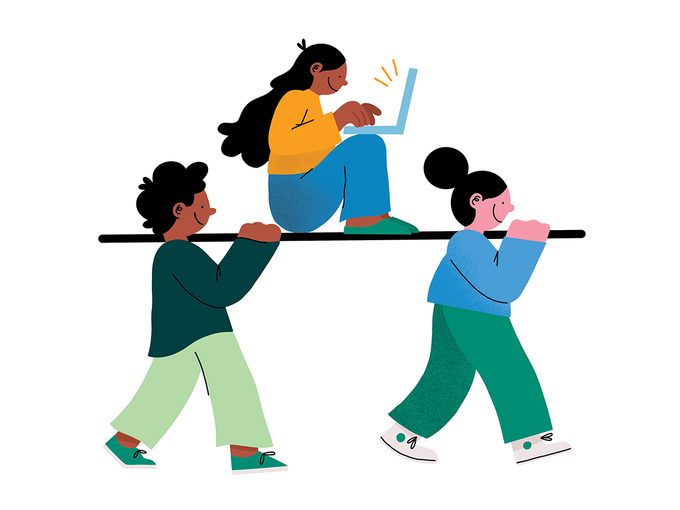How Your Work Can Actually Support Your Wellness (No, Seriously)

From pay transparency to a four-day work week to menopause toolkits, here are ways to overhaul your work-life balance—that people are doing right now.
A traumatized workforce—that’s what HR expert and advocate Allison Venditti says we’re dealing with in the back half of 2022. “There was no time to process anything in the middle of a disaster,” she says. “But now, people are re-evaluating what they want.” And what Canadian employees want most, according to a study by wellness firm LifeWorks, is flexibility.
It’s the key to work-life balance, says Bryan Smale, professor emeritus of recreation and leisure studies at the University of Waterloo: “The more flexibility you have to allocate your time in a way that best suits your lifestyle, the happier you are.” (He should know—he’s also the director of the Canadian Index of Wellbeing.) But flexibility in the workplace can contort itself into many forms: where you work, when you work, how you’re compensated. “There are a lot of ways to work within a budget to give people the things they want,” Venditti says. “But the days of ‘good job, here’s a pen’ are over.”
Here’s how to create a better work-life balance.

Take your time back with the four-day work week
It was the summer of 2021—well past the one-year anniversary of the global pandemic that transformed the future of work—and the employees of a Winnipeg branding and strategy agency were burnt out. “People were just done,” says Lee Waltham, managing partner at Brandish. He and his leadership team knew their staff needed a break, but the idea of closing up shop for a week felt too drastic. So they shut down for seven.
Well, overall. After a two-month experiment ditching Fridays, Brandish made the permanent switch to a four-day work week last fall, joining Canadian employers like environmental non-profit EcoSuperior, software firm Coconut and Toronto’s Juno College (who could not be reached for comment as they had closed for a week “to give our employees a break”). “That’s 52 days you’re getting back,” says Waltham. Fifty-two days, or seven and a half weeks—but who’s counting?
Joe O’Connor, for one. The Irish labour advocate is the CEO of 4 Day Week Global, a non-profit that is in the middle of the largest-ever trial of reduced work hours, involving 3,500 employees across 70 U.K. companies. (Other trials are in the works for the United States, Australia and New Zealand. Canada’s kicks off October 3.) He saw an uptick in interest in the four-day week about the time Waltham noticed his employees burning out. “The first 12 months of the pandemic were all about the shift to remote work and putting out fires,” says O’Connor. “Then people could start thinking about what’s next.”
The four-day week isn’t the only way companies are trying to lessen the load on workers; some offer increased personal and sick days. But O’Connor emphasizes that universal leave can be extremely discretionary. “An individual’s gender, their seniority, how much agency they feel they have, their manager’s belief in the policy,” he says, “all of that affects whether someone actually takes leave.” A four-day work week, on the other hand, is a structural shift that requires change at the departmental level—tackling meeting bloat, eliminating interruptions, making use of productivity tools—to enable a team to work smarter. And if done right—the 4 Day Week Global team spends months preparing companies for the shift—it doesn’t lead to work intensification, either. Before starting their trial, 50 percent of employees at one company felt they had enough time to complete their work. After the trial, that number rose to 80 percent. Waltham concurs: “There was really no disruption, in terms of productivity or performance. People were happier and less stressed.”
And it can help keep future burnout at bay. “This is something we can do long term,” Waltham says. “It’s sustainable.” It’s also contagious: One of Brandish’s clients implemented a four-day week, and now some 800 more Winnipeggers enjoy a steady supply of long weekends.
One of the main objections to the four-day week is that it won’t suit certain industries, so O’Connor made sure to recruit care services, manufacturers and fast-food establishments to the pilots. “We can point to case studies where a shorter work week has worked in pretty much every industry that exists,” he says.
When workers packed up and went home in March of 2020, they unknowingly launched a years-long experiment between employers and employees that has resulted in a desire for more autonomy and flexibility at work. “Managers have been forced to trust workers a lot more,” says O’Connor. “As a result, the four-day week is a much less radical concept to get your head around. It’s the next logical step.”
(Related: 5 Canadians with Disabilities on the Upsides of Working from Home)

Amp up your benefits
The increased demand for flexibility doesn’t just apply to time. “A lot of companies are moving towards more flexible benefits,” says Tiana Field-Ridley, senior program manager for workplace mental health at the Mental Health Commission of Canada. “Flex packages” let you allocate contributions to the services you need and use, so you don’t max out your therapy allowance or massage treatments while leaving $750 of acupuncture untouched. Some providers offer a perk for employers, too: They only pay for what employees use (minus an administration fee).
These savings might help make benefits more widely available in industries that haven’t typically offered them. Toronto restaurants Marben and Barque Smokehouse recently started providing flex packages for all their staff; both use Olympia Benefits for physical health services. As part of the change in compensation model, David Neinstein, owner of Barque Smokehouse, eliminated tipping and instead paid staff a higher hourly wage. “We talked about the new model, and I said I understand if you want to go elsewhere,” Neinstein says. “No one did. The benefits made the difference.”
Then there are companies whose benefits take a broad, inclusive view of what people might need. SAP, a German software company with offices in Canada, includes support for employees with diabetes and cancer, on top of coverage for fertility treatments, gender affirmation therapies and procedures, adoption costs and telehealth. For Field-Ridley, a robust benefits package is about more than just good dental (though that’s key, too). It can help create a workplace that’s protective. “And one that recognizes it’s not just the work that’s important anymore,” says FieldRidley. “People are important.”
Go on that vacation
Compressed days and reduced hours address the need for flexibility on an ongoing basis, but sometimes you just need a week—or three—off. Unlimited paid time off gets a bad rap, since workers offered this policy take fewer days off than employees with a fixed allocation. “Sometimes, it’s because of guilt,” says Field-Ridley. “Or because their workload is too much.” Plus, with no balance to use or lose, vacations just aren’t prioritized. “There need to be parameters around these policies,” she says, “like minimum weeks employees must take or mandatory time off where the whole organization shuts down.”
Marketing agency Peachy has a minimum—there’s no maximum—paid vacation policy of 15 days; marketing software company Hubspot has a “global week of rest” on top of unlimited days and a “vacation quota relief” policy to ensure salespeople take a break, too. Organization app Evernote encourages employees to take advantage of its unlimited days policy with a $1,000 vacation stipend, provided the break is at least five days long. Streaming service Roku’s unlimited time off policy states that “you can take what you think is appropriate, as long as you get your job done and don’t impact the team’s work,” which reflects the trust and autonomy workers are looking for. “People want to get their projects done,” says Field-Ridley. “They just don’t want to feel like they’re owned by a company anymore.”
(Related: Vacation Doesn’t Solve Burnout)

Know your worth
We tapped Allison Venditti, HR expert and founder of advocacy group Moms at Work, to answer our questions on the value of pay transparency.
Why do we need pay transparency? We’re programmed to not talk about money, and that only benefits companies. Women are systemically underpaid, which continues through your whole career, because every time you apply for a new job, your salary is based on your last job. It’s a cycle. Pay transparency ensures that women, people of colour, people with disabilities— whoever—are able to decide if they would like to work for an organization in a way that they never were before
Has there been a shift in interest since the pandemic? The number of LinkedIn posts that list salary rose by 44 percent compared to a year ago. It’s an employee market, and if I’m going to jump through the ridiculous hoops of the recruitment process—write a cover letter, do a project, meet the whole team—all of it usually unpaid, tell me what you’re going to pay me.
How does it impact employee satisfaction? Pay transparency builds trust and helps with retention. Companies are screaming “We need to retain women!” To close the leak in your talent pipeline, you need to pay women. And if a woman finds out she’s making 30 percent less than a male counterpart—well, bad HR is bad PR, and people will talk about it.
And know the worth of your profession: Female-dominated jobs—customer support or HR, for instance— tend to have the lowest salaries, and this not so-fun fact doesn’t get addressed simply by making sure everyone in the same role is (under)paid equally. Unito, a Montreal software start-up that also has a policy of pay transparency, ran the numbers and increased the base salary for these roles by 4 percent to try to further close the industry wage gap.

Support your colleagues
For many, the past few years of remote work have been a long-overdue break from the racist aggressions (micro and otherwise) of the office. That’s probably why a recent study by Slackled consortium Future Forum found that the desire for a hybrid or fully remote work arrangement was stronger in Asian, Black and Hispanic/Latinx employees than in white employees. “When you remove yourself from an environment that’s hurting you a little bit every day,” says Dr. Helen Ofosu, a career coach and HR consultant, “you realize how much better you feel.” The Ottawa expert cautions that as employees return to the office, it’s more important than ever to level the uneven playing field created by systemic inequities in the workplace.
A lot can be accomplished through clear communication. A 2022 study by Hue, a U.S. non-profit that works to amplify BIPOC voices and visibility in the workplace, found that while 80 percent of responding companies had implemented diversity initiatives, only a quarter of BIPOC employees knew about them. According to Dr. Ofosu, the same lack of transparency exists around training budgets. “So some people get most of the money and others go without,” she says, “creating a differential in who gets access to training and professional development.” Targeted, formal mentorship programs can help over time. “When you have someone who’s looking out for you, willing to vouch for you, share lessons learned along the way—all those things add up,” says Dr. Ofosu.
The Hue study found that BIPOC employees are three times as likely as their white colleagues to consider leaving their job due to the emotional burden related to their race at work. One way to reduce that load would be to recognize the labour performed by certain staff—those who participate in employee resource groups, for instance—for what it is: work. “At some companies, those employees get a reduction in their other duties,” says Dr. Ofosu. “If an organization is serious about improving inclusion, those extra activities should be built into someone’s role—not added on top of it.




